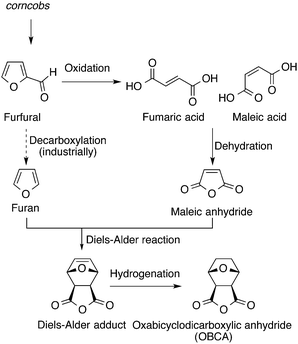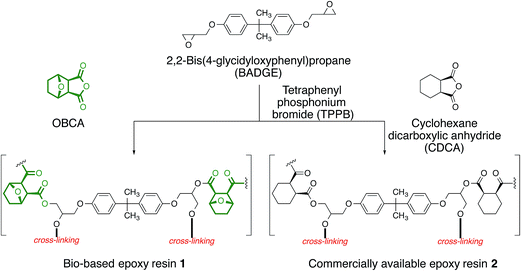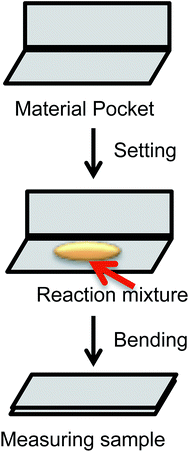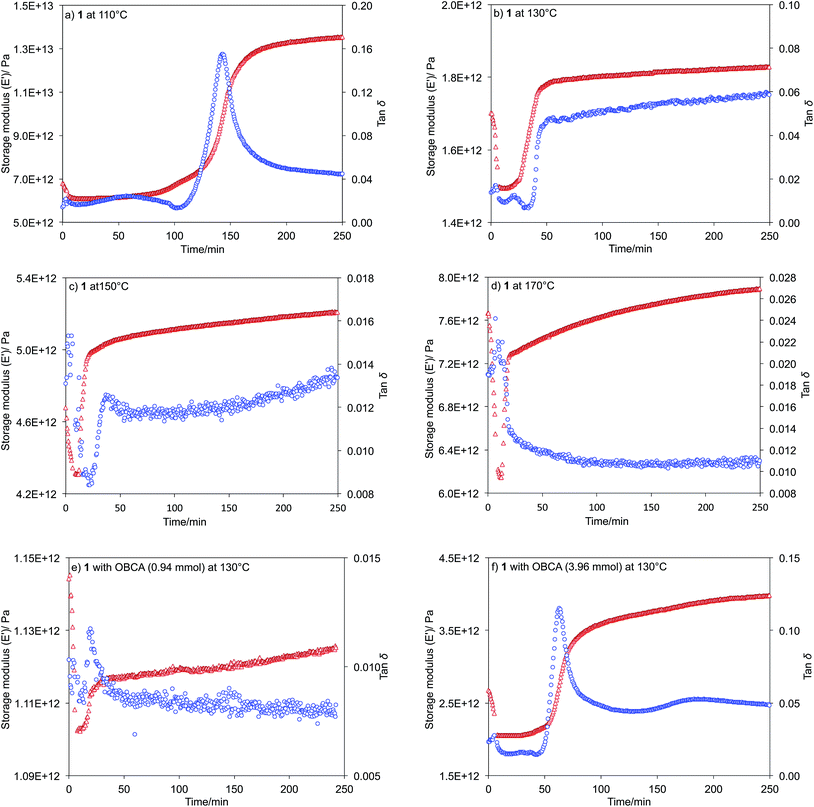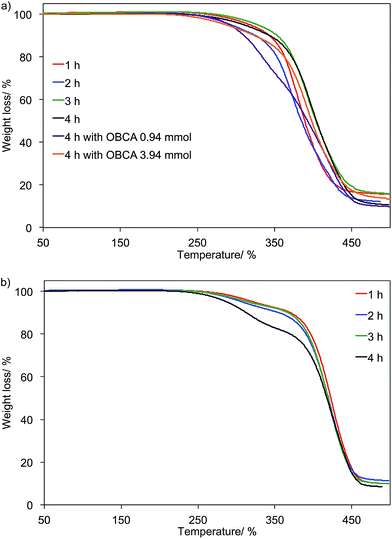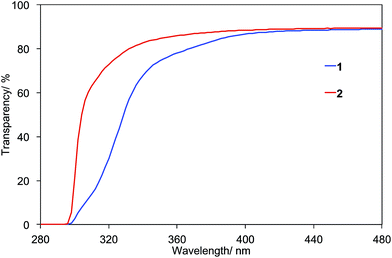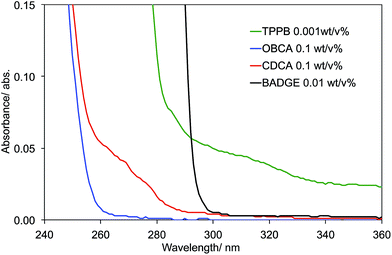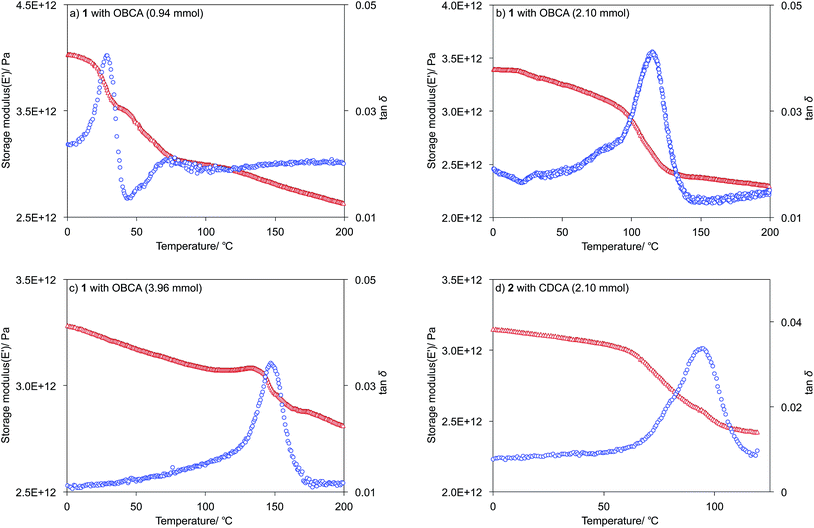Hardening process and properties of an epoxy resin with bio-based hardener derived from furfural
Yuya Tachibanaab,
Junko Toriia,
Ken-ichi Kasuya*a,
Masahiro Funabashic and
Masao Kuniokac
aDivision of Molecular Science, Faculty of Science and Technology, Gunma University, 1-5-1 Tenjin, Kiryu, Gunma 376-8515, Japan. E-mail: kkasuya@gunma-u.ac.jp
bJapan Science and Technology Agency (JST), PRESTO, 4-1-8 Honcho, Kawaguchi, Saitama 332-0012, Japan
cNational Institute of Advanced Industrial Science and Technology (AIST), Higashi 1-1-1, Tsukuba, Ibaraki 305-8565, Japan
First published on 21st October 2014
Abstract
The development of bio-based plastics is an important research area because of its contribution to environmental preservation. Herein, we evaluated the properties of a bio-based epoxy resin synthesised using 2,2-bis(4-glycidyloxyphenyl)propane as the epoxy monomer and oxabicyclodicarboxylic anhydride (OBCA) as a bio-based hardener derived from furfural. The major hardening process of the resin at 130 °C, manifested in an exponential increase in the storage modulus, was complete within an hour, which was longer than that for a commercially available petroleum-based epoxy resin hardened using cis-cyclohexane dicarboxylic anhydride (CDCA). This indicated that OBCA was less reactive than CDCA, which has a similar structure. The bio-based epoxy resin showed excellent transparency in the visible light region and was thermally stable, with 5% weight loss at temperatures exceeding 270 °C. Glass transition temperatures were above 100 °C, and mechanical properties were moderately better than those of the commercially available epoxy resin. Moreover, the bio-based carbon content ranged from 21% to 53%, depending on the amount of OBCA added. Thus, the bio-based OBCA is a good hardener for a bio-based epoxy resin that can be used as a value-added material in industrial applications.
Introduction
The use of biomass resources contributes to the prevention of global warming and depletion of petroleum resources. To reduce the amount of petroleum used for plastics production, the development of various bio-based commodity plastics is an industrially and academically important area of research. The biodegradable polymers poly(lactic acid) (PLA),1,2 produced from corn seed, and poly(hydroxy alkanoate) (PHA),3 produced from plant oil and sugar, were developed as commercially available bio-based materials. Since this century, bio-based polyethylene4 produced from bio-ethanol and partially bio-based polyethylene terephthalate,5 in which the ethylene glycol unit is produced from bio-ethanol, has been used in manufacturing. The development of other commodity plastics such as polypropylene,6 polyvinyl chloride,6 and poly(butylene succinate)7 is also in progress.Epoxy resin is one of the most important thermosetting resins for industrial applications such as coating material for automobiles, ships, and bridges to prevent corrosion, sealant for electrical devices for protection from air and moisture, and adhesive for buildings, automobiles, aircrafts, and sporting goods.8,9 Epoxy resins comprise monomers that contain at least two epoxide groups and can react with polyfunctional hardeners like amines, acid, alcohols, thiols, and anhydrides to give high-performance cross-linked resins. A mixture of an epoxy monomer and hardener is usually cured by external stimulation such as UV irradiation or heating to give epoxy resin, and the properties of the cured resin can be controlled by the hardener and cure time. Compared to other commercially available polymers, some epoxy resins are expensive. However, these are widely used in manufacturing because of their high performance and availability, which give added value to the cost of material. Although the additional cost of production usually precludes the utilization of bio-based epoxy resins in manufacturing, this can be outweighed by superior properties of these resins.
A few bio-based epoxy resins have been synthesised from bio-based epoxy monomers and bio-based hardeners.10,11 Epichlorohydrin, which is generally used as an epoxy monomer, was synthesised from glycerol derived from natural fat, which is a by-product of bio-diesel and a surfactant.12 The hydroxyl groups of lignin derivatives react with epichlorohydrin to give epoxy monomers.13 Recently, the conversion and curing of itaconic acid was reported.14 Vegetable oil containing an unsaturated fatty acid moiety was also converted to an epoxy monomer through epoxidation of the double bond.15 Bio-based polyfunctional compounds like vegetable oil,16 polysaccharide,17 and polylysine18 were converted to hardeners with thiol or amino groups. Cyclic acid anhydrides are usually used as a hardener in manufacturing, and bio-based acid anhydrides can be obtained from abietic acid or maleopimarate.19
The bio-based carbon content, defined as the ratio of carbons derived from biomass to the total carbon of the material, has been established in ASTM, CEN, and ISO,20 and is thus an objective standard to evaluate bio-based materials. The amount of hardener in an epoxy resin is substantial, usually over 30%. Therefore, the bio-based carbon content of an epoxy resin is sufficient for a bio-based polymer, even if only the hardener is derived from biomass.
We have focused on furan derivatives produced from cellulose and hemicellulose as biomass resources to produce polymers. Furan derivatives, such as 5-hydroxymethylfurfural (HMF), furfural, furfuryl alcohol, and furan, are produced from biomass resources and used industrially as organic solvents or resins.21–24 The U.S. Department of Energy has stated that these are the most value-added chemicals derived from biomass.25 Therefore, considerable effort has been expended in their efficient conversion from biomass resources.26–28
Furfural was previously converted to oxabicyclodicarboxylic anhydride (OBCA) through the synthetic route shown in Scheme 1. OBCA is known as norcantharidin, which is an anti-cancer drug.29 Its polymerization with diols leads to formation of bio-based polyoxabicyclates (POBCs) that can replace commercially available transparent elastic polymers.30 The properties of POBCs depend on the rigidity, bulkiness, and reactivity of OBCA, which is an oxo-bridged cyclohexane dicarboxylic anhydride.
In this study, we demonstrate that OBCA can act as a bio-based hardener using 2,2-bis(4-glycidyloxyphenyl)propane (BADGE) as the epoxy monomer and tetraphenylphosphonium bromide (TPPB) as the catalyst to obtain a bio-based epoxy resin. BADGE has two epoxide groups and is formed by the condensation between bisphenol A and epichlorohydrin. It is a commercially available epoxy monomer widely used in manufacturing.31 To evaluate OBCA as a hardener, a commodity epoxy resin was also synthesised for comparison using cis-cyclohexane dicarboxylic anhydride (CDCA). The hardening process of each epoxy resin was evaluated as time-dependent properties using dynamic mechanical analysis (DMA) at the hardening temperature. The chemical structure after hardening was analysed using Fourier transform infrared (FT-IR) spectroscopy. Optical properties were evaluated using ultraviolet-visible (UV-vis) spectroscopy. Thermal stability was measured using thermal gravimetric analysis (TGA). The mechanical properties of the moulded specimens were assessed based on tensile strength and temperature-dependent DMA. The latter was also used to obtain thermal properties.
Experimental
Materials
2,2-Bis(4-glycidyloxyphenyl)propane (BADGE), tetraphenylphosphonium bromide (TPPB), and cis-cyclohexane dicarboxylic anhydride (CDCA) were purchased from Tokyo Kasei Industry Co., Ltd. (Tokyo, Japan) and used without further purification. The synthesis of OBCA from furfural was described in our previous study.31Instrumentation
Pre-treatment was performed using a thermo-mighty stirrer (HHE-19G-USII; Koike Precision Instruments, Hyogo, Japan) with an aluminium block bath. Compressed moulding was done using a hot-pressing machine (Mini Press Test 10; Toyo Seiki Seisaku-sho Ltd., Tokyo, Japan). FT-IR spectra were obtained using an FT-IR spectrophotometer (Nicolet iS50 FT-IR; Thermo Fisher Scientific K.K., Yokohama, Japan) equipped with a single-reflection attenuated total reflectance (ATR) system (Spectra-Tech Foundation Performer). Thermal stability was determined by thermal gravimetric analysis (TGA-50; Shimadzu Co., Kyoto, Japan) conducted up to 500 °C at a rate of 10 °C min−1. The transparency of 0.20 mm thick epoxy resin films was measured using a UV-vis spectrophotometer (UV-1700; Shimadzu Co., Kyoto, Japan) in the wavelength range 190–1100 nm. Dynamic mechanical properties were measured using a dynamic mechanical analyser (DMA8000; PerkinElmer Inc., Waltham, MA, USA) in single cantilever bending mode at an oscillatory frequency of 1.0 Hz and an applied deformation of 0.05 mm during heating. To measure the thermal properties, i.e., storage modulus (E′) and tan![[thin space (1/6-em)]](https://www.rsc.org/images/entities/char_2009.gif) δ (E′′/E′), as a function of temperature, temperature scans from 0 °C were performed at a heating rate of 2 °C min−1. The kinetics was measured isothermally at 130 °C, and E′ and tan
δ (E′′/E′), as a function of temperature, temperature scans from 0 °C were performed at a heating rate of 2 °C min−1. The kinetics was measured isothermally at 130 °C, and E′ and tan![[thin space (1/6-em)]](https://www.rsc.org/images/entities/char_2009.gif) δ were recorded as a function of time (min). The strength and strain of the specimens at breaking point were measured at room temperature by performing tensile strength tests with a universal material testing machine (EZ-test; Shimadzu). The grip distance was 10 mm and the speed rate of the tensile strength test was 10 mm min−1.
δ were recorded as a function of time (min). The strength and strain of the specimens at breaking point were measured at room temperature by performing tensile strength tests with a universal material testing machine (EZ-test; Shimadzu). The grip distance was 10 mm and the speed rate of the tensile strength test was 10 mm min−1.
General procedure for time-dependent DMA
BADGE (449 mg, 1.32 mmol) and dicarboxylic anhydride (2.10 mmol) were added to a 2 ml disposable test tube. After stirring the mixture vigorously at 100 °C for 10 min to dissolve the acid anhydride, TPPB (4 mg, 10 μmol) was added. The mixture was stirred with a magnetic stirrer at 100 °C for 10 min. The resulting viscous liquid (∼5 mg) was placed on the Material Pocket and dynamic mechanical properties were measured. The thermal program consisted of heating from 30 to 130 °C at 20 °C min−1 for 5 min and maintaining the temperature at 130 °C for 240 min.General procedure for pressing moulding31,32
The viscous liquid, as prepared above, was centrifuged to remove air bubbles. The transparent liquid was then placed on a mould made of polypropylene (40 × 40 × 0.2 mm) and pressed at 5 MPa and 130 °C for an arbitrary amount of time.General procedure for tensile strength testing
The compressed film was cut into specimens (20 mm long, 1.0 mm wide, 0.2 mm deep). The tensile strength was taken as the maximum strength required to break the material on the stress–strain curve. The tensile strain at the breaking point was taken as the maximum strain on the stress–strain curve. An average value for each specimen was taken from several sample measurements under the same conditions.Results and discussion
Hardening process
Thermal hardening with bio-based OBCA gave the bio-based epoxy resin 1 as shown in Scheme 2. To evaluate the effect of the oxabicyclic moiety of OBCA on resin properties, CDCA was also used as a hardener to give the commercially available epoxy resin 2. CDCA has a similar structure to OBCA except for the oxo bridge.The thermal hardening process was investigated by carrying out a time-dependent dynamic mechanical analysis based on isothermal measurements at ambient temperature. The rheology of the hardening process is commonly evaluated by separately analysing the viscous liquid and solid material using a rheometer and by dynamic mechanical analysis, respectively. However, it is possible to evaluate both states using the latter with a Material Pocket made of stainless plate as done in this study. The pre-mixing viscous liquid sample was placed between the two halves of the Material Pocket and compressed carefully to avoid leakage as shown in Fig. 1. The sample was immediately heated to the hardening temperature within 5 min and the temperature was kept constant while measuring isothermal properties. The changes in E′ and tan![[thin space (1/6-em)]](https://www.rsc.org/images/entities/char_2009.gif) δ (Fig. 2) showed the hardening behaviour of 1 and 2 at different hardening temperatures.
δ (Fig. 2) showed the hardening behaviour of 1 and 2 at different hardening temperatures.
The value of E′ at the initial temperature (0 °C) was different from that at the hardening temperature; however, this did not arise from the temperature difference, but from the use of the Material Pocket to handle the sample in the DMA apparatus. The decrease in E′ of 1 during heating to the isothermal temperature indicates that the viscosity of the reaction mixture decreased with temperature. E′ exponentially increased after hardening to form the cross-linked network began (major hardening process), and almost reached a plateau when hardening was nearly complete. The major hardening process at 110, 130, 150, and 179 °C was almost done within 155, 43, 21, and 19 min, respectively; thus, as the hardening temperature increased, the corresponding time shortened. On the other hand, the E′ of 1 continued to increase gradually at all temperatures even after the initial exponential rise and the elapsed time was over 250 min, which indicates that a minor hardening process occurred even after the major one. This result coincided with those of thermal gravimetric analysis and tensile strength testing as will be discussed below.
The time-dependent hardening behaviour of 2 at 130 °C is shown in Fig. 3. The E′ of 2 exponentially increased between 5 and 16 min and then almost reached a plateau, similar to 1 (Fig. 2b), although the increase for the latter occurred between 21 and 43 min. This indicated that the hardening process of 2 at 130 °C also began immediately and was nearly complete in 16 min. However, a minor hardening process gradually continued after the major one. The change in the E′ of 1 in this plateau region was larger than that of 2. This suggests that the reactivity of OBCA with BADGE was lower than that of CDCA. The difference in reactivity can be attributed to the bulky oxabicyclic moiety of OBCA that sterically hinders the acid anhydride moiety.
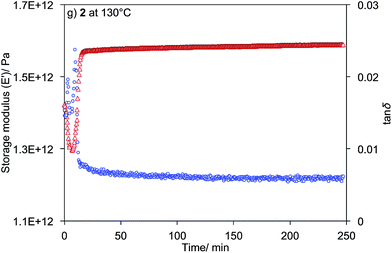 | ||
Fig. 3 Time-dependent dynamic mechanical analysis. Storage modulus E′ (red open triangles) and tan![[thin space (1/6-em)]](https://www.rsc.org/images/entities/char_2009.gif) δ (blue open circles) of 2 at 130 °C during isothermal analysis. δ (blue open circles) of 2 at 130 °C during isothermal analysis. | ||
In addition, the hardening behaviour of 1 and 2 indicates that the cross-linked network possibly formed during the major hardening process while residual functional groups, such as epoxy and carboxylic acid, possibly reacted in the cross-linked network during the minor hardening process. The change in physical properties resulting from the minor hardening process was insignificant after 60 min at all hardening temperatures; however, the change was smallest at 130 °C. Hereafter, the properties of bio-based epoxy resin 1 will be evaluated using the samples that hardened at 130 °C.
The ratio between the epoxy and hardener usually affects the properties of the epoxy resin.8 Initially, an epoxy/hardener mole ratio of 1.32/2.10 was adopted. The E′ and tan![[thin space (1/6-em)]](https://www.rsc.org/images/entities/char_2009.gif) δ of 1 at a ratio of 1.32/0.94 and 1.32/3.96 are shown in Fig. 2e and f, respectively. The hardening time depended on the amount of hardener. The major hardening process of 1 was complete at 22, 43, and 75 min using 0.94, 2.10, and 3.96 mmol of OBCA, respectively. As the amount of OBCA increased, the time required for the major hardening process became longer. With a small amount of OBCA, the cross-linked network formed is low density. Therefore, the hardening process could rapidly proceed because the hardener could easily move through the low-density network. On the other hand, the hardening process became slower in proportion to the amount of OBCA as the cross-linked network became denser. Furthermore, the high flexibility of the moulded film of 1, obtained using 0.94 mmol OBCA, compared with the other films indicates the formation of a low-density cross-linked network. The physical properties of 1 obtained using 0.94 mmol OBCA are listed in Table 1.
δ of 1 at a ratio of 1.32/0.94 and 1.32/3.96 are shown in Fig. 2e and f, respectively. The hardening time depended on the amount of hardener. The major hardening process of 1 was complete at 22, 43, and 75 min using 0.94, 2.10, and 3.96 mmol of OBCA, respectively. As the amount of OBCA increased, the time required for the major hardening process became longer. With a small amount of OBCA, the cross-linked network formed is low density. Therefore, the hardening process could rapidly proceed because the hardener could easily move through the low-density network. On the other hand, the hardening process became slower in proportion to the amount of OBCA as the cross-linked network became denser. Furthermore, the high flexibility of the moulded film of 1, obtained using 0.94 mmol OBCA, compared with the other films indicates the formation of a low-density cross-linked network. The physical properties of 1 obtained using 0.94 mmol OBCA are listed in Table 1.
| Epoxy resin | Amount of hardener/mmol | Hardening time/h | Bio-based carbon content | Td5%b/°C | Tgc/°C | Young's modulusd/GPa | Tensile Strengthd/MPa | Strain at breaking pointd/% |
|---|---|---|---|---|---|---|---|---|
| a Hardened at 130 °C and 5 MPa.b Measured by thermal gravimetric analysis.c Measured by dynamical mechanical analysis.d Measured by tensile strength testing. | ||||||||
| 1 | 2.10 | 1 | 38 | 317 | 115 | 0.9 ± 0.4 | 55.8 ± 5.3 | 6.1 ± 1.6 |
| 2.10 | 2 | 38 | 293 | 116 | 1.3 ± 0.5 | 65.2 ± 4.3 | 6.0 ± 1.2 | |
| 2.10 | 3 | 38 | 328 | 116 | 1.2 ± 0.1 | 59.8 ± 5.0 | 5.3 ± 1.0 | |
| 0.94 | 4 | 21 | 292 | 28 | 0.37 ± 0.1 | 9.5 ± 1.3 | 69.3 ± 7.3 | |
| 2.10 | 4 | 38 | 310 | 115 | 1.6 ± 0.5 | 68.0 ± 11 | 5.2 ± 1.0 | |
| 3.94 | 4 | 53 | 287 | 146 | 2.8 ± 0.3 | 63.9 ± 25 | 3.9 ± 1.3 | |
| 2 | 2.10 | 1 | 0 | 322 | 83 | 1.2 ± 0.1 | 66.7 ± 5.3 | 6.3 ± 1.8 |
| 2.10 | 2 | 0 | 307 | 89 | 1.2 ± 0.3 | 67.8 ± 8.6 | 5.7 ± 1.2 | |
| 2.10 | 3 | 0 | 315 | 94 | 1.0 ± 0.2 | 63.0 ± 4.5 | 6.2 ± 1.1 | |
| 2.10 | 4 | 0 | 286 | 93 | 0.8 ± 0.2 | 68.0 ± 3.4 | 7.5 ± 1.8 | |
The bio-based carbon contents of 1 and 2 are summarized in Table 1 as well. The bio-based carbon contents of the epoxy resin hardened using 0.94, 2.10, and 3.96 mmol OBCA were 21, 38, and 53%, respectively. This indicates that the bio-based carbon content of 1 can be easily increased by using the bio-based hardener OBCA, which derives its carbons from bio-based furfural.
Chemical structure analysis
The change in chemical structure after the hardening process was determined from the FT-IR spectra. The peaks at 1607 and 1509 cm−1 observed in the BADGE spectrum shown in Fig. 4a were assigned to aromatic stretching vibrations. OBCA and CDCA had several peaks around 1700–1800 cm−1 due to the aliphatic cyclic acid anhydride. The peaks at 1842 and 1774 cm−1 observed in the OBCA spectrum (Fig. 4b) and those at 1856 and 1786 cm−1 observed in the CDCA spectrum (Fig. 4c) were assigned to symmetric and asymmetric carbonyl stretching vibrations, respectively. After hardening for 4 h, these peaks disappeared and a peak at 1745 cm−1 assigned to the carbonyl ester stretching vibration appeared in the spectra of both 1 and 2 as shown in Fig. 4e and g, respectively. These indicate that acid anhydrides reacted with epoxy groups to yield esters, which formed the cross-linked network in the epoxy resin. On the other hand, the relative intensities of the peak at 1509 cm−1 due to BADGE and that at 1745 cm−1 due to the ester bond formed by hardening changed with the amount of OBCA as shown in Fig. 4d–f.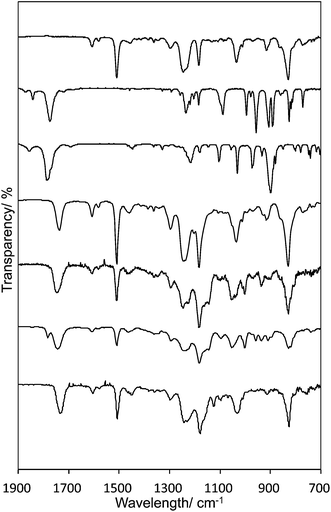 | ||
| Fig. 4 IR spectra of (a) BAGDE, (b) OBCA, (c) CDCA, (d) 1 (0.94 mmol OBCA), (e) 1 (2.10 mmol OBCA), (f) 1 (3.96 mmol OBCA), and g) 2. | ||
When the amount of OBCA used in 1 was 3.96 mmol, the peak at 1856 cm−1 due to acid anhydride was still observed 4 h from the beginning of hardening as shown in Fig. 4f. Although one BADGE molecule having two epoxide groups can theoretically react with four OBCA molecules, it was difficult to complete the hardening process with stoichiometric amounts of OBCA and BADGE owing to the high-density cross-linked network, which could interfere with the reaction between the epoxide and acid anhydride. If the reaction proceeds stoichiometrically, the epoxy resin becomes a fragile material owing to the presence of four OBCA units at the termini of bisphenol A. Therefore, residual OBCA was left from the initial 3.96 mmol after the four-hour hardening process.
As mentioned above, the hardening process did not reach completion after 4 h. We then attempted to identify the residual functional groups during the hardening of 1 with 0.94 mmol OBCA. Each sample of 1 and 2 was prepared as a 0.2 mm thick film at different hardening times (1, 2, 3, and 4 h) by the hot-pressing method at 5 MPa and 130 °C. All epoxy resin films were transparent and hard at each hardening time. However, the residual functional groups could not be identified as the difference in the hardening time was not manifested in the IR spectra.
Thermal stability
The dependence of thermal stability on the hardening time was evaluated using thermal gravimetric analysis conducted up to 500 °C under a nitrogen atmosphere. The TGA curves are shown in Fig. 5 and 5% weight loss temperatures (Td5%) are summarized in Table 1. No dependency of Td5% on the hardening time and amount of OBCA was observed. This result indicates that the thermal stability did not depend on the minor hardening process. The Td5% of 1 at different hardening times was comparable to that of 2, demonstrating that the oxabicyclic moiety in 1 hardly affected the thermal stability of the epoxy resin. Thus, the thermal stability of 1 was as good as that of 2, which is currently used in industries.Optical property
Optical properties were measured using UV-vis spectroscopy. No clear relationship between transparency and hardening time was observed as in the thermal gravimetric analysis. Therefore, only the spectra of 1 and 2 hardened for 4 h are shown in Fig. 6. The decrease in the transparency of 2 was initially gradual from 330 nm and became steeper from 300 nm. On the other hand, the transparency of 1 gradually decreased from 390 nm and then sharply decreased from 340 nm. Subsequently, specific absorption was observed around 310–320 nm. Since this difference between the transparency of 1 and 2 was observed in all samples hardened for 1, 2, 3, and 4 h, it can be attributed to the difference in the chemical structure of the anhydride moiety of the hardeners. The UV-vis spectra of the monomers are shown in Fig. 7. BADGE and TPPB had a strong absorption band below 300 nm due to the aromatic ring. While CDCA had a strong absorption band below 280 nm due to the carbonyl double bond, no strong absorption band was observed for OBCA above 260 nm. These indicate that the side reaction of OBCA reported previously30 occurred during the hardening process and some resulting functional groups had absorption between 310 and 350 nm. Although we attempted to determine these functional groups using FT-IR analysis, the characteristic peaks were not observed.Dynamic mechanical properties
To evaluate the thermal properties of 1 and 2 hardened at 130 °C for 4 h, dynamic mechanical analysis was performed with varying temperature, from 0 °C at a heating rate of 2 °C min−1. The E′ and tan![[thin space (1/6-em)]](https://www.rsc.org/images/entities/char_2009.gif) δ of 1 using 0.92, 2.10, or 3.96 mmol OBCA and 2 are shown in Fig. 8. The glass transition temperature (Tg), the temperature at which tan
δ of 1 using 0.92, 2.10, or 3.96 mmol OBCA and 2 are shown in Fig. 8. The glass transition temperature (Tg), the temperature at which tan![[thin space (1/6-em)]](https://www.rsc.org/images/entities/char_2009.gif) δ was a maximum, is summarized in Table 1. The E′ of 1 using 0.94, 2.10, and 3.96 mmol OBCA was 3.8, 3.4, and 3.3 GPa, respectively, at 25 °C. These results indicate that there is no significant relationship between E′ and the amount of OBCA.
δ was a maximum, is summarized in Table 1. The E′ of 1 using 0.94, 2.10, and 3.96 mmol OBCA was 3.8, 3.4, and 3.3 GPa, respectively, at 25 °C. These results indicate that there is no significant relationship between E′ and the amount of OBCA.
On the other hand, the Tg of 1 increased with increasing amount of OBCA. Thus, a large amount of OBCA led to the formation of a high-density cross-linked network, resulting in a heat-resistant epoxy resin. The Tg of 1 hardened using 0.94 mmol OBCA was around room temperature; therefore, this moulded sample was more flexible than the others. In comparison, the E′ and Tg of 2 using 2.10 mmol CDCA were 3.1 GPa and 93 °C. Tg is an important parameter to consider in choosing an epoxy resin for industrial use. The Tg of 1 was above the boiling point of water (100 °C) while that of 2 was not, which makes the thermal properties of the former superior to the latter.
Tensile strength
The mechanical properties of 1 and 2 hardened at 130 °C at 5 MPa were determined using tensile strength testing. Young's modulus, tensile strength, and strain at breaking point are summarized in Table 1. The tensile strength of 1 was almost the same as that of 2, while strain at breaking point of 1 was smaller than that of 2. This suggests that the oxabicyclic moiety in 1 hindered the elongation owing to its bulkiness and imparted hardness to the sample. With increasing hardening time, Young's modulus and the tensile strength of 1 increased and those of 2 decreased, while the strain at breaking point of 1 decreased and that of 2 increased. These results suggest that the hardening process of 1 and 2 gradually continued even after the major hardening process was complete, as explained above.The mechanical properties of 1 using 0.94 mmol OBCA indicate that it is more flexible than other epoxy resins owing to its low-density cross-linked network. Conversely, 1 using 3.96 mmol OBCA was more fragile than others owing to its high-density cross-linked network.
Conclusion
A novel bio-based epoxy resin was successfully synthesised using the bio-based acid anhydride OBCA derived solely from furfural. The bio-based carbon content of the epoxy resins was 21–53% depending on the amount of OBCA added. Isothermal measurements using the dynamic mechanical analyser demonstrated that the major hardening process was complete within 1 h. On the other hand, the rate of hardening with OBCA was slower than with CDCA owing to the bulkiness and lower reactivity of the former. Nevertheless, 1 was found to be thermally stable as an epoxy resin. Although the transparency of 1 was excellent in the visible light region, the absorption band of a by-product derived from OBCA was observed below 380 nm. The high Tg of 1 compared to 2 indicated that OBCA imparted thermal resistance to epoxy resins. Finally, its mechanical properties were almost the same as those of 2. These favourable features of 1 can be attributed to the effect of the oxabicyclic moiety. In addition, the side reaction of this moiety, which was also observed in our previous study on polyesters containing OBCA,31 enhanced the physical properties of the epoxy resin. Thus, 1 is suitable for industrial applications and preferable to 2 because it is a bio-based material.Although BADGE was chosen as the epoxy in this study to evaluate OBCA as a hardener, other epoxies including the bio-based ones that were previously reported can also be used.10–13 A bio-based epoxy and bio-based OBCA hardener will thus give a fully bio-based epoxy resin.
Acknowledgements
This work, under the project “Creation of essential technologies to utilize carbon dioxide as a resource through the enhancement of plant productivity and the exploitation of plant products,” was supported by the Precursory Research for Embryonic Science and Technology (PRESTO) program of the Japan Science and Technology Agency (JST).References
- J. Lunt, Polym. Degrad. Stab., 1998, 59, 145 CrossRef CAS.
- E. T. H. Vink, K. R. Rábago, D. A. Glassner and P. R. Gruber, Polym. Degrad. Stab., 2003, 80, 403 CrossRef CAS.
- K. Sudesh, H. Abe and Y. Doi, Prog. Polym. Sci., 2000, 25, 1503 CrossRef CAS.
- A. Morschbacker, Polym. Rev., 2009, 49, 79 CrossRef CAS.
- R. Mülhaupt, Macromol. Chem. Phys., 2013, 214, 159 CrossRef.
- R. T. Mathers, J. Polym. Sci., Part A: Polym. Chem., 2012, 50, 1 CrossRef CAS.
- Y. Tachibana, T. Masuda, M. Funabashi and M. Kunioka, Biomacromolecules, 2010, 11, 2760 CrossRef CAS PubMed.
- Epoxy Polymers: New Materials and Innovations, ed. J.-P. Pascault and R. J. J. Williams, Wiley-VCH, Weinheim, 2010 Search PubMed.
- R. S. Bauer, in Applied Polymer Science, ed. R. W. Tess and G. W. Poehlein, American Chemical Society, Washington, DC, 2nd edn, ACS Symposium Series 285, 1985, pp. 931–961 Search PubMed.
- R. Auvergne, S. Caillol, G. David, B. Boutevin and J.-P. Pascault, Chem. Rev., 2014, 114, 1082 CrossRef CAS PubMed.
- J.-M. Raquez, M. Deléglise, M.-F. Lacrampe and P. Krawczak, Prog. Polym. Sci., 2010, 35, 487 CrossRef CAS PubMed.
- L. Shen, E. Worrell and M. Patel, Biofuels, Bioprod. Biorefin., 2010, 4, 25 CrossRef CAS.
- T. Koike, Polym. Eng. Sci., 2012, 52, 701 CAS.
- S. Ma, X. Liu, Y. Jiang, Z. Tang, C. Zhang and J. Zhu, Green Chem., 2013, 15, 245 RSC.
- M. Galià, L. M. de Espinosa, J. C. Ronda, G. Lligadas and V. Cádiz, Eur. J. Lipid Sci. Technol., 2010, 112, 87 CrossRef.
- T. Takahashi, K. Hirayama, N. Teramoto and M. Shibata, J. Appl. Polym. Sci., 2008, 108, 1596 CrossRef CAS.
- N. Illy, S. Benyahya, N. Durand, R. Auvergne, S. Caillol, G. David and B. Boutevin, Polym. Int., 2014, 63, 420 CrossRef CAS.
- Y. Takada, K. Shinbo, Y. Someya and M. Shibata, J. Appl. Polym. Sci., 2009, 113, 479 CrossRef CAS.
- H. Wang, X. Liu, B. Liu, J. Zhang and M. Xian, Polym. Int., 2009, 58, 1435 CrossRef CAS.
- M. Kunioka, K. Taguchi, F. Ninomiya, M. Nakajima, A. Saito and S. Araki, Polymers, 2014, 6, 423 CrossRef PubMed.
- O. W. Cass, Ind. Eng. Chem. Res., 1948, 40, 216 CrossRef CAS.
- F. Trimble, Ind. Eng. Chem., 1941, 33, 660 CrossRef CAS.
- J. P. Trickey, C. S. Miner and H. J. Brownlee, Ind. Eng. Chem., 1923, 15, 65 CrossRef CAS.
- W. J. Mckillip, in Adhesives from Renewable Resources, ed. R. W. Hemingway, A. H. Conner and S. J. Branham, American Chemical Society, Washington, DC, ACS Symposium Series 385, 1989, pp. 408–423 Search PubMed.
- J. J. Bozell and G. R. Petersen, Green Chem., 2010, 12, 539 RSC.
- R. Weingarten, J. Cho, W. C. Conner, Jr and G. W. Huber, Green Chem., 2010, 12, 1423 RSC.
- P. L. Dhepe and R. Sahu, Green Chem., 2010, 12, 2153 RSC.
- A. Cukalovic and C. V. Stevens, Green Chem., 2010, 12, 1201 RSC.
- A. McCluskey and J. A. Sakoff, Mini-Rev. Med. Chem., 2001, 1, 43 CrossRef CAS.
- Y. Tachibana, M. Yamahata and K. Kasuya, Green Chem., 2013, 15, 1318 RSC.
- New Japan Chemical Co., Ltd, Japan Pat., A 2003-26763, 2003.
- G. Pan, Z. Du, C. Zhang, C. Li, X. Yang and H. Li, Polym. J., 2007, 39, 478 CrossRef CAS.
| This journal is © The Royal Society of Chemistry 2014 |

